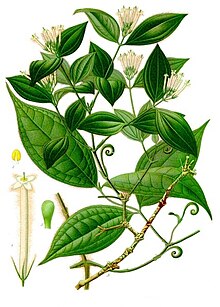
Back كورار (سم) Arabic Кураре Bulgarian Curare Catalan Kurare Czech Curare German Κουράριο Greek Curâr EML Kuraro Esperanto Curare Spanish Kuraare Estonian
You can help expand this article with text translated from the corresponding article in French. (March 2014) Click [show] for important translation instructions.
|
The article's lead section may need to be rewritten. (May 2019) |


Curare (/kʊˈrɑːri/ or /kjʊˈrɑːri/; kuu-RAH-ree or kyuu-RAH-ree) is a common name for various alkaloid arrow poisons originating from plant extracts. Used as a paralyzing agent by indigenous peoples in Central and South America for hunting and for therapeutic purposes, curare only becomes active when it contaminates a wound or is introduced directly to the bloodstream; it is not active when ingested orally. These poisons cause weakness of the skeletal muscles and, when administered in a sufficient dose, eventual death by asphyxiation due to paralysis of the diaphragm. Curare is prepared by boiling the bark of one of the dozens of plant sources, leaving a dark, heavy paste that can be applied to arrow or dart heads. In medicine, curare has been used as a treatment for tetanus and strychnine poisoning and as a paralyzing agent for surgical procedures.
© MMXXIII Rich X Search. We shall prevail. All rights reserved. Rich X Search